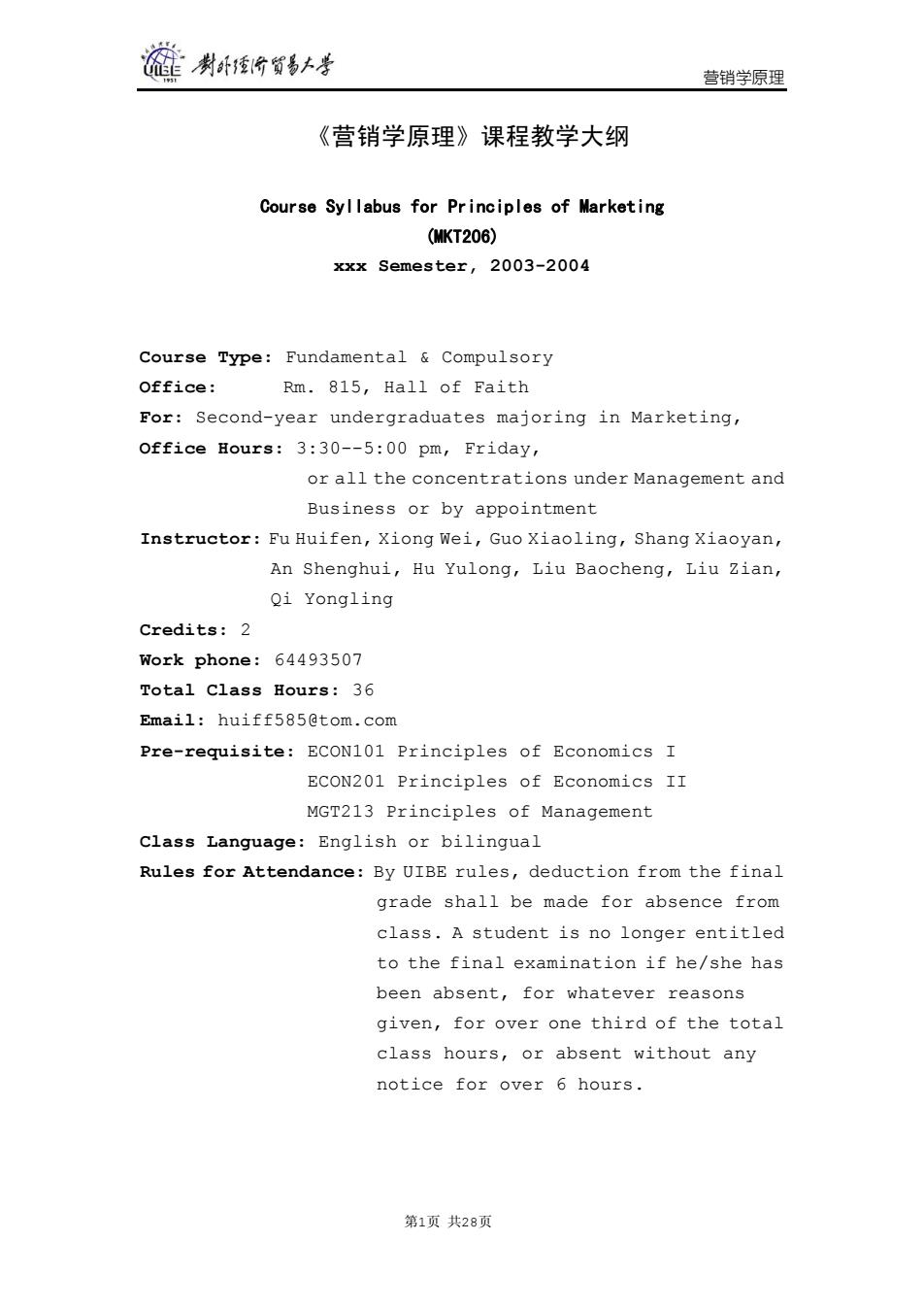
溢 制研价贸号上号 营销学原理 《营销学原理》课程教学大纲 Course Syllabus for Principles of Marketing (MKT206) xxx Semester,2003-2004 Course Type:Fundamental Compulsory Office: Rm.815,Hall of Faith For:Second-year undergraduates majoring in Marketing, office Hours:3:30--5:00 pm,Friday, or all the concentrations under Management and Business or by appointment Instructor:Fu Huifen,Xiong Wei,Guo Xiaoling,Shang Xiaoyan, An Shenghui,Hu Yulong,Liu Baocheng,Liu Zian, Qi Yongling Credits:2 Work phone:64493507 Total Class Hours:36 Email:huiff585@tom.com Pre-requisite:ECON101 Principles of Economics I ECON201 Principles of Economics II MGT213 Principles of Management Class Language:English or bilingual Rules for Attendance:By UIBE rules,deduction from the final grade shall be made for absence from class.A student is no longer entitled to the final examination if he/she has been absent,for whatever reasons given,for over one third of the total class hours,or absent without any notice for over 6 hours. 第1页共28页
营销学原理 《营销学原理》课程教学大纲 Course Syllabus for Principles of Marketing (MKT206) xxx Semester, 2003-2004 Course Type: Fundamental & Compulsory Office: Rm. 815, Hall of Faith For: Second-year undergraduates majoring in Marketing, Office Hours: 3:30--5:00 pm, Friday, or all the concentrations under Management and Business or by appointment Instructor: Fu Huifen, Xiong Wei, Guo Xiaoling, Shang Xiaoyan, An Shenghui, Hu Yulong, Liu Baocheng, Liu Zian, Qi Yongling Credits: 2 Work phone: 64493507 Total Class Hours: 36 Email: huiff585@tom.com Pre-requisite: ECON101 Principles of Economics I ECON201 Principles of Economics II MGT213 Principles of Management Class Language: English or bilingual Rules for Attendance: By UIBE rules, deduction from the final grade shall be made for absence from class. A student is no longer entitled to the final examination if he/she has been absent, for whatever reasons given, for over one third of the total class hours, or absent without any notice for over 6 hours. 第1页 共28页
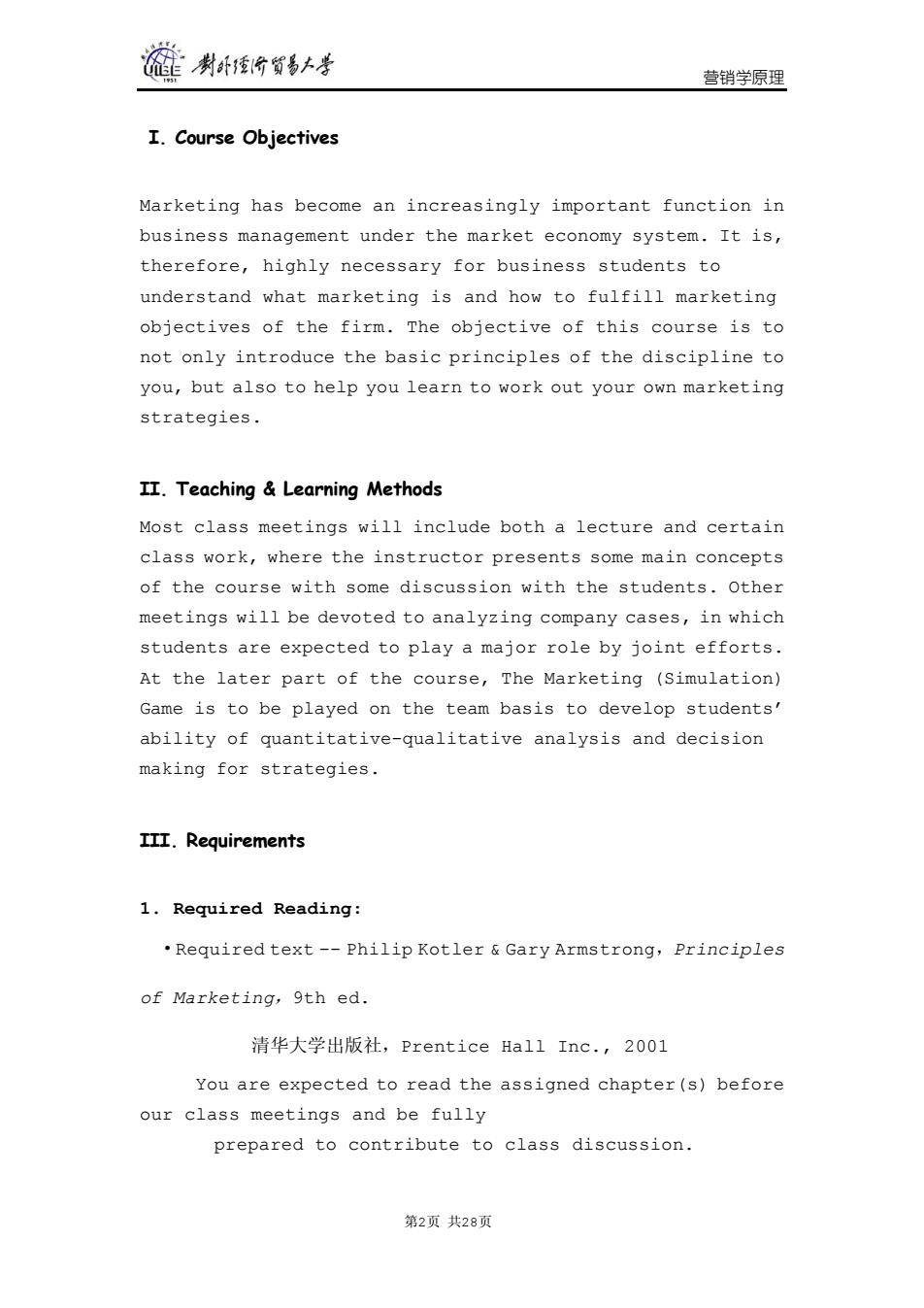
莲 制卧价贸易卡孝 营销学原理 I.Course Objectives Marketing has become an increasingly important function in business management under the market economy system.It is, therefore,highly necessary for business students to understand what marketing is and how to fulfill marketing objectives of the firm.The objective of this course is to not only introduce the basic principles of the discipline to you,but also to help you learn to work out your own marketing strategies. II.Teaching Learning Methods Most class meetings will include both a lecture and certain class work,where the instructor presents some main concepts of the course with some discussion with the students.Other meetings will be devoted to analyzing company cases,in which students are expected to play a major role by joint efforts. At the later part of the course,The Marketing (Simulation) Game is to be played on the team basis to develop students' ability of quantitative-qualitative analysis and decision making for strategies. III.Requirements 1.Required Reading: Required text--Philip Kotler Gary Armstrong,Principles of Marketing,9th ed. 清华大学出版社,Prentice Hal1Inc.,2001 You are expected to read the assigned chapter(s)before our class meetings and be fully prepared to contribute to class discussion. 第2页共28页
营销学原理 I. Course Objectives Marketing has become an increasingly important function in business management under the market economy system. It is, therefore, highly necessary for business students to understand what marketing is and how to fulfill marketing objectives of the firm. The objective of this course is to not only introduce the basic principles of the discipline to you, but also to help you learn to work out your own marketing strategies. II. Teaching & Learning Methods Most class meetings will include both a lecture and certain class work, where the instructor presents some main concepts of the course with some discussion with the students. Other meetings will be devoted to analyzing company cases, in which students are expected to play a major role by joint efforts. At the later part of the course, The Marketing (Simulation) Game is to be played on the team basis to develop students’ ability of quantitative-qualitative analysis and decision making for strategies. III. Requirements 1. Required Reading: ·Required text -- Philip Kotler & Gary Armstrong,Principles of Marketing,9th ed. 清华大学出版社,Prentice Hall Inc., 2001 You are expected to read the assigned chapter(s) before our class meetings and be fully prepared to contribute to class discussion. 第2页 共28页
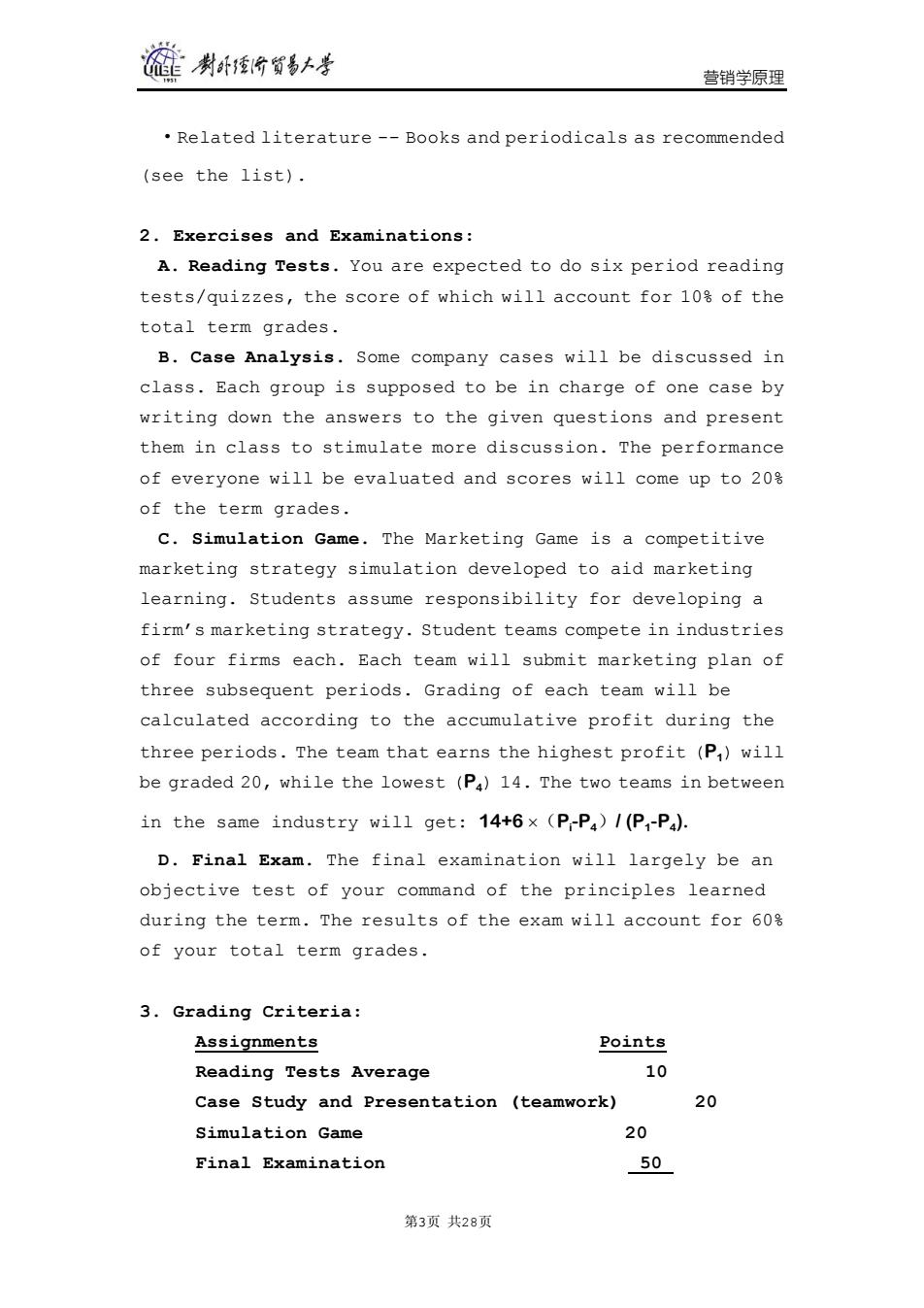
莲 制卧台贸多上考 营销学原理 Related literature--Books and periodicals as recommended (see the list). 2.Exercises and Examinations: A.Reading Tests.You are expected to do six period reading tests/quizzes,the score of which will account for 10%of the total term grades. B.Case Analysis.Some company cases will be discussed in class.Each group is supposed to be in charge of one case by writing down the answers to the given questions and present them in class to stimulate more discussion.The performance of everyone will be evaluated and scores will come up to 20% of the term grades. C.Simulation Game.The Marketing Game is a competitive marketing strategy simulation developed to aid marketing learning.Students assume responsibility for developing a firm's marketing strategy.Student teams compete in industries of four firms each.Each team will submit marketing plan of three subsequent periods.Grading of each team will be calculated according to the accumulative profit during the three periods.The team that earns the highest profit (P)will be graded 20,while the lowest (P)14.The two teams in between in the same industry will get:14+6x (P-P)/(P,-P4). D.Final Exam.The final examination will largely be an objective test of your command of the principles learned during the term.The results of the exam will account for 60% of your total term grades. 3.Grading Criteria: Assignments Points Reading Tests Average 10 Case Study and Presentation (teamwork) 20 Simulation Game 20 Final Examination 50 第3页共28页
营销学原理 ·Related literature -- Books and periodicals as recommended (see the list). 2. Exercises and Examinations: A. Reading Tests. You are expected to do six period reading tests/quizzes, the score of which will account for 10% of the total term grades. B. Case Analysis. Some company cases will be discussed in class. Each group is supposed to be in charge of one case by writing down the answers to the given questions and present them in class to stimulate more discussion. The performance of everyone will be evaluated and scores will come up to 20% of the term grades. C. Simulation Game. The Marketing Game is a competitive marketing strategy simulation developed to aid marketing learning. Students assume responsibility for developing a firm’s marketing strategy. Student teams compete in industries of four firms each. Each team will submit marketing plan of three subsequent periods. Grading of each team will be calculated according to the accumulative profit during the three periods. The team that earns the highest profit (P1) will be graded 20, while the lowest (P4) 14. The two teams in between in the same industry will get: 14+6 ×(Pi -P4)/ (P1-P4). D. Final Exam. The final examination will largely be an objective test of your command of the principles learned during the term. The results of the exam will account for 60% of your total term grades. 3. Grading Criteria: Assignments Points Reading Tests Average 10 Case Study and Presentation (teamwork) 20 Simulation Game 20 Final Examination 50 第3页 共28页
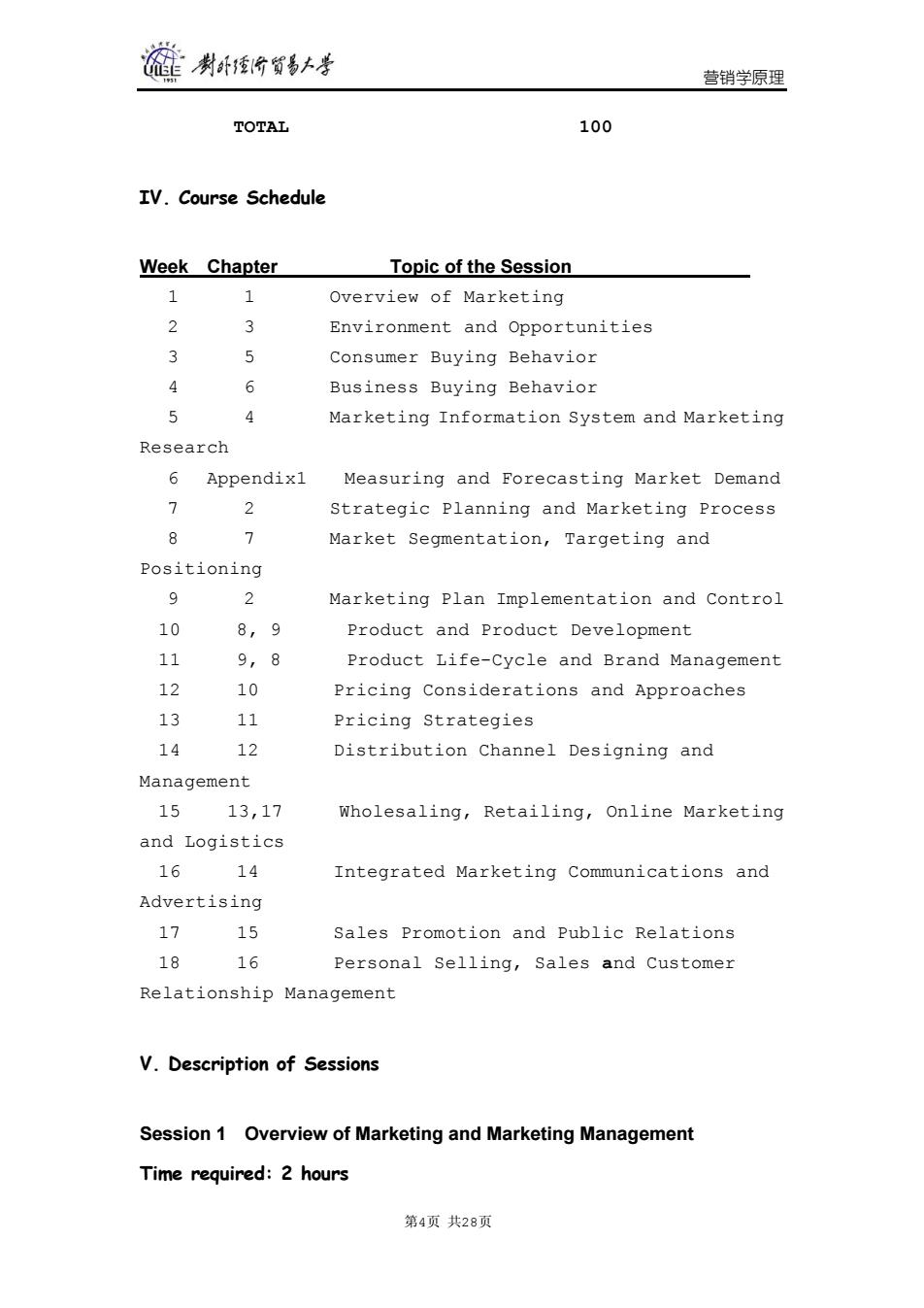
制卧价贸易+考 营销学原理 TOTAL 100 IV.Course Schedule Week Chapter Topic of the Session 1 Overview of Marketing 2 3 Environment and Opportunities 3 5 Consumer Buying Behavior 9 6 Business Buying Behavior 5 4 Marketing Information System and Marketing Research 6 Appendix1 Measuring and Forecasting Market Demand 7 2 Strategic Planning and Marketing Process 8 7 Market Segmentation,Targeting and Positioning 9 2 Marketing Plan Implementation and Control 10 8,9 Product and Product Development 11 9,8 Product Life-Cycle and Brand Management 12 10 Pricing Considerations and Approaches 13 11 Pricing Strategies 14 12 Distribution Channel Designing and Management 15 13,17 Wholesaling,Retailing,Online Marketing and Logistics 16 14 Integrated Marketing Communications and Advertising 17 15 Sales Promotion and Public Relations 18 16 Personal Selling,Sales and Customer Relationship Management V.Description of Sessions Session 1 Overview of Marketing and Marketing Management Time required:2 hours 第4页共28页
营销学原理 TOTAL 100 IV. Course Schedule Week Chapter Topic of the Session 1 1 Overview of Marketing 2 3 Environment and Opportunities 3 5 Consumer Buying Behavior 4 6 Business Buying Behavior 5 4 Marketing Information System and Marketing Research 6 Appendix1 Measuring and Forecasting Market Demand 7 2 Strategic Planning and Marketing Process 8 7 Market Segmentation, Targeting and Positioning 9 2 Marketing Plan Implementation and Control 10 8, 9 Product and Product Development 11 9, 8 Product Life-Cycle and Brand Management 12 10 Pricing Considerations and Approaches 13 11 Pricing Strategies 14 12 Distribution Channel Designing and Management 15 13,17 Wholesaling, Retailing, Online Marketing and Logistics 16 14 Integrated Marketing Communications and Advertising 17 15 Sales Promotion and Public Relations 18 16 Personal Selling, Sales and Customer Relationship Management V. Description of Sessions Session 1 Overview of Marketing and Marketing Management Time required: 2 hours 第4页 共28页

制卧价贸易+学 营销学原理 Text:Chapter 1 Objectives Requirements Be aware of reasons for studying marketing general framework of Marketing goals of the marketing system how marketing is used by different kinds of organizations Essential Concepts definition of Marketing, the Generic Value Chain ·the Value Equation the core marketing concepts (need,want,demand,value,satisfaction,exchange, relationship,etc.) ·demand management marketing system goals major philosophies of marketing (production concept,product concept,marketing concept,etc.) Text Chapter and Supplementary Materials Chapter 1,Kotler Armstrong,Principles of Marketing 9th ed. References at the end of the chapter,and in the Course Syllabus Exercises and Discussion Marketing Applications:Question 1 (a-e) Issues for Discussion: 1.What has happened to Qinchi in the following case? 2.Which marketing philosophy did the management take when Qinchi made its fame? What was the consequence of it? 3.What lesson can you draw out of it? (背景:昔日广告“标王”盛名不再,秦池酒厂要整体出售) Case Analysis 1."Princeline.com:Changing Business in the New Millennium",Principles of Marketinged. 2.《海尔集团》(《当代营销学案例集》) Session 2 Environment and Opportunities 第5页共28页
营销学原理 Text: Chapter 1 Objectives & Requirements Be aware of • reasons for studying marketing • general framework of Marketing • goals of the marketing system • how marketing is used by different kinds of organizations Essential Concepts • definition of Marketing, • the Generic Value Chain • the Value Equation • the core marketing concepts (need, want, demand, value, satisfaction, exchange, relationship, etc.) • demand management • marketing system goals • major philosophies of marketing (production concept, product concept, marketing concept, etc.) Text Chapter and Supplementary Materials Chapter 1,Kotler & Armstrong, Principles of Marketing 9th ed. References at the end of the chapter, and in the Course Syllabus Exercises and Discussion Marketing Applications: Question 1 (a – e) Issues for Discussion: 1. What has happened to Qinchi in the following case? 2. Which marketing philosophy did the management take when Qinchi made its fame? What was the consequence of it? 3. What lesson can you draw out of it? (背景:昔日广告“标王”盛名不再,秦池酒厂要整体出售) Case Analysis 1. “Princeline.com: Changing Business in the New Millennium”,Principles of Marketing 9th ed. 2.《海尔集团》(《当代营销学案例集》) Session 2 Environment and Opportunities 第5页 共28页
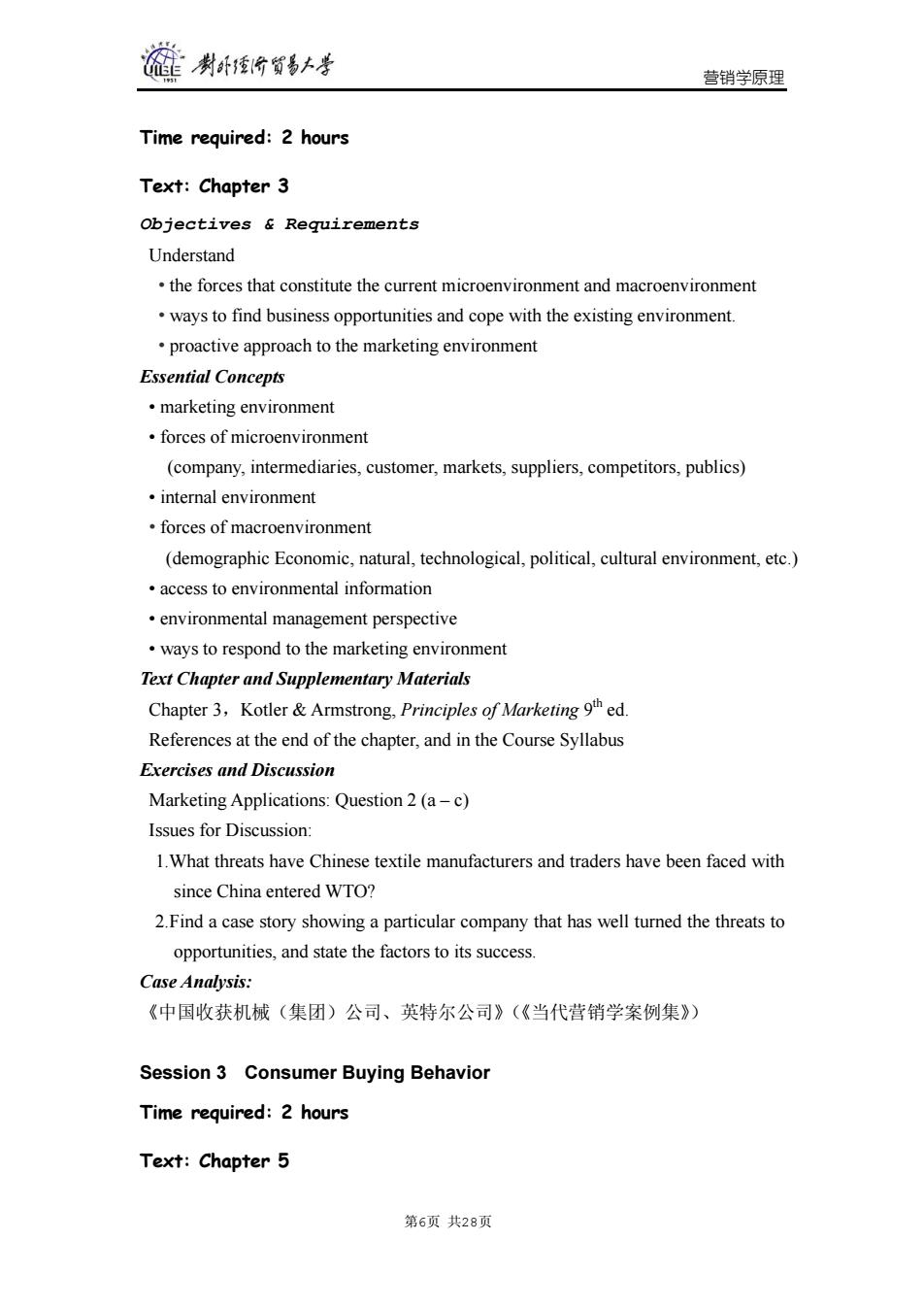
旌 制卧价贸易+学 营销学原理 Time required:2 hours Text:Chapter 3 Objectives Requirements Understand the forces that constitute the current microenvironment and macroenvironment ways to find business opportunities and cope with the existing environment. proactive approach to the marketing environment Essential Concepts marketing environment forces of microenvironment (company,intermediaries,customer,markets,suppliers,competitors,publics) internal environment forces of macroenvironment (demographic Economic,natural,technological,political,cultural environment,etc.) access to environmental information environmental management perspective ways to respond to the marketing environment Text Chapter and Supplementary Materials Chapter 3,Kotler&Armstrong,Principles of Marketinged. References at the end of the chapter,and in the Course Syllabus Exercises and Discussion Marketing Applications:Question 2 (a-c) Issues for Discussion: 1.What threats have Chinese textile manufacturers and traders have been faced with since China entered WTO? 2.Find a case story showing a particular company that has well turned the threats to opportunities,and state the factors to its success. Case Analysis: 《中国收获机械(集团)公司、英特尔公司》(《当代营销学案例集》) Session 3 Consumer Buying Behavior Time required:2 hours Text:Chapter 5 第6页共28页
营销学原理 Time required: 2 hours Text: Chapter 3 Objectives & Requirements Understand • the forces that constitute the current microenvironment and macroenvironment • ways to find business opportunities and cope with the existing environment. • proactive approach to the marketing environment Essential Concepts • marketing environment • forces of microenvironment (company, intermediaries, customer, markets, suppliers, competitors, publics) • internal environment • forces of macroenvironment (demographic Economic, natural, technological, political, cultural environment, etc.) • access to environmental information • environmental management perspective • ways to respond to the marketing environment Text Chapter and Supplementary Materials Chapter 3,Kotler & Armstrong, Principles of Marketing 9th ed. References at the end of the chapter, and in the Course Syllabus Exercises and Discussion Marketing Applications: Question 2 (a – c) Issues for Discussion: 1.What threats have Chinese textile manufacturers and traders have been faced with since China entered WTO? 2.Find a case story showing a particular company that has well turned the threats to opportunities, and state the factors to its success. Case Analysis: 《中国收获机械(集团)公司、英特尔公司》(《当代营销学案例集》) Session 3 Consumer Buying Behavior Time required: 2 hours Text: Chapter 5 第6页 共28页
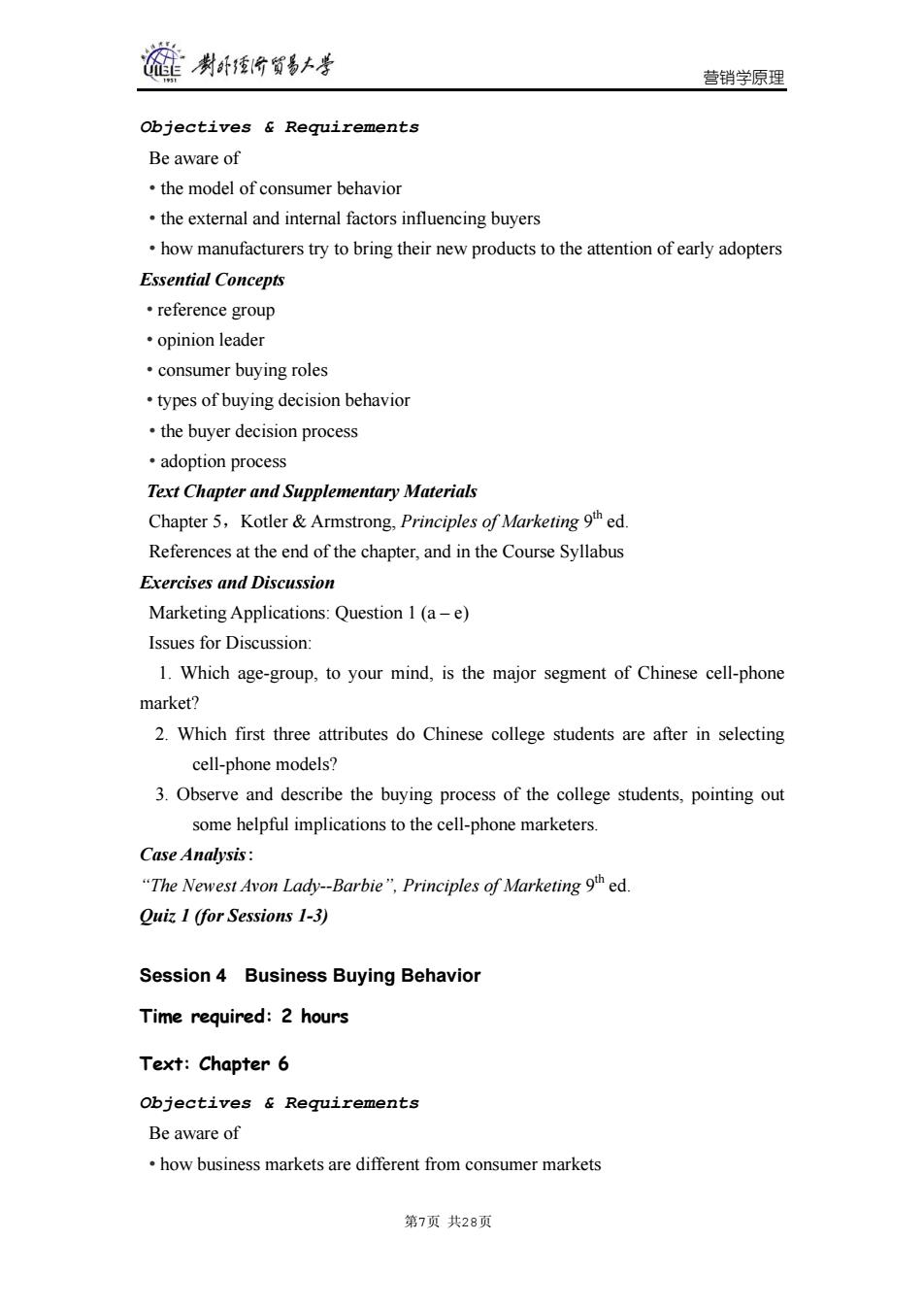
制卧价贸易+学 营销学原理 Objectives Requirements Be aware of the model of consumer behavior the external and internal factors influencing buyers how manufacturers try to bring their new products to the attention of early adopters Essential Concepts ·reference group ·opinion leader consumer buying roles types of buying decision behavior the buyer decision process ·adoption process Text Chapter and Supplementary Materials Chapter 5,Kotler Armstrong,Principles of Marketing 9th ed. References at the end of the chapter,and in the Course Syllabus Exercises and Discussion Marketing Applications:Question 1 (a-e) Issues for Discussion: 1.Which age-group,to your mind,is the major segment of Chinese cell-phone market? 2.Which first three attributes do Chinese college students are after in selecting cell-phone models? 3.Observe and describe the buying process of the college students,pointing out some helpful implications to the cell-phone marketers. Case Analysis: "The Newest Avon Lady--Barbie"Principles of Marketing 9ed. Quiz 1 (for Sessions 1-3) Session 4 Business Buying Behavior Time required:2 hours Text:Chapter 6 Objectives Requirements Be aware of how business markets are different from consumer markets 第7页共28页
营销学原理 Objectives & Requirements Be aware of • the model of consumer behavior • the external and internal factors influencing buyers • how manufacturers try to bring their new products to the attention of early adopters Essential Concepts • reference group • opinion leader • consumer buying roles • types of buying decision behavior • the buyer decision process • adoption process Text Chapter and Supplementary Materials Chapter 5,Kotler & Armstrong, Principles of Marketing 9th ed. References at the end of the chapter, and in the Course Syllabus Exercises and Discussion Marketing Applications: Question 1 (a – e) Issues for Discussion: 1. Which age-group, to your mind, is the major segment of Chinese cell-phone market? 2. Which first three attributes do Chinese college students are after in selecting cell-phone models? 3. Observe and describe the buying process of the college students, pointing out some helpful implications to the cell-phone marketers. Case Analysis: “The Newest Avon Lady--Barbie”, Principles of Marketing 9th ed. Quiz 1 (for Sessions 1-3) Session 4 Business Buying Behavior Time required: 2 hours Text: Chapter 6 Objectives & Requirements Be aware of • how business markets are different from consumer markets 第7页 共28页
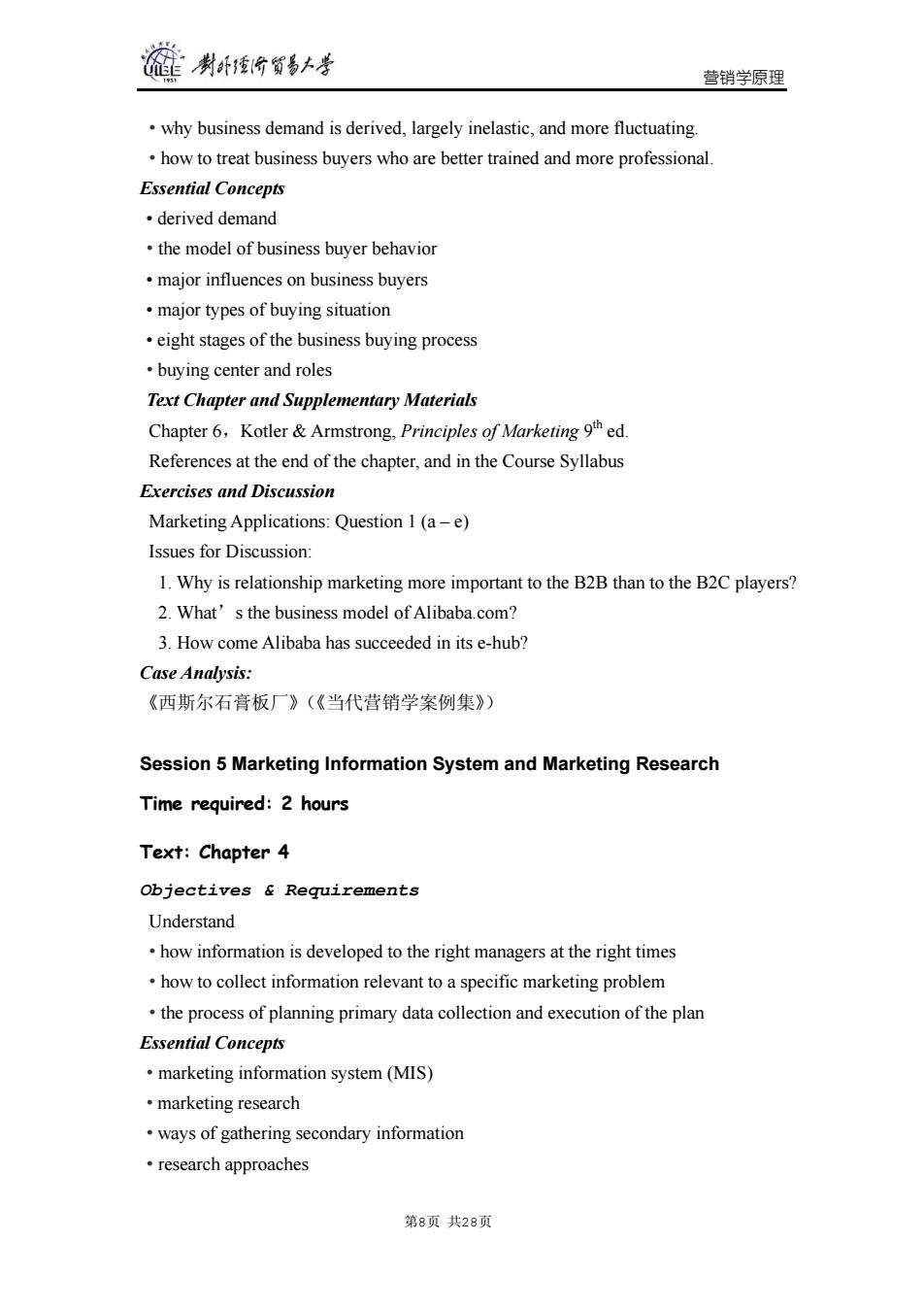
制卧爱分贸易+学 营销学原理 why business demand is derived,largely inelastic,and more fluctuating. how to treat business buyers who are better trained and more professional Essential Concepts ·derived demand the model of business buyer behavior major influences on business buyers major types of buying situation eight stages of the business buying process buying center and roles Text Chapter and Supplementary Materials Chapter6,Kotler&Armstrong,Principles of Marketinged. References at the end of the chapter,and in the Course Syllabus Exercises and Discussion Marketing Applications:Question 1(a-e) Issues for Discussion: 1.Why is relationship marketing more important to the B2B than to the B2C players? 2.What's the business model of Alibaba.com? 3.How come Alibaba has succeeded in its e-hub? Case Analysis: 《西斯尔石膏板厂》(《当代营销学案例集》) Session 5 Marketing Information System and Marketing Research Time required:2 hours Text:Chapter 4 Objectives Requirements Understand how information is developed to the right managers at the right times how to collect information relevant to a specific marketing problem the process of planning primary data collection and execution of the plan Essential Concepts marketing information system (MIS) ·marketing research ways of gathering secondary information ·research approaches 第8页共28页
营销学原理 • why business demand is derived, largely inelastic, and more fluctuating. • how to treat business buyers who are better trained and more professional. Essential Concepts • derived demand • the model of business buyer behavior • major influences on business buyers • major types of buying situation • eight stages of the business buying process • buying center and roles Text Chapter and Supplementary Materials Chapter 6,Kotler & Armstrong, Principles of Marketing 9th ed. References at the end of the chapter, and in the Course Syllabus Exercises and Discussion Marketing Applications: Question 1 (a – e) Issues for Discussion: 1. Why is relationship marketing more important to the B2B than to the B2C players? 2. What’s the business model of Alibaba.com? 3. How come Alibaba has succeeded in its e-hub? Case Analysis: 《西斯尔石膏板厂》(《当代营销学案例集》) Session 5 Marketing Information System and Marketing Research Time required: 2 hours Text: Chapter 4 Objectives & Requirements Understand • how information is developed to the right managers at the right times • how to collect information relevant to a specific marketing problem • the process of planning primary data collection and execution of the plan Essential Concepts • marketing information system (MIS) • marketing research • ways of gathering secondary information • research approaches 第8页 共28页
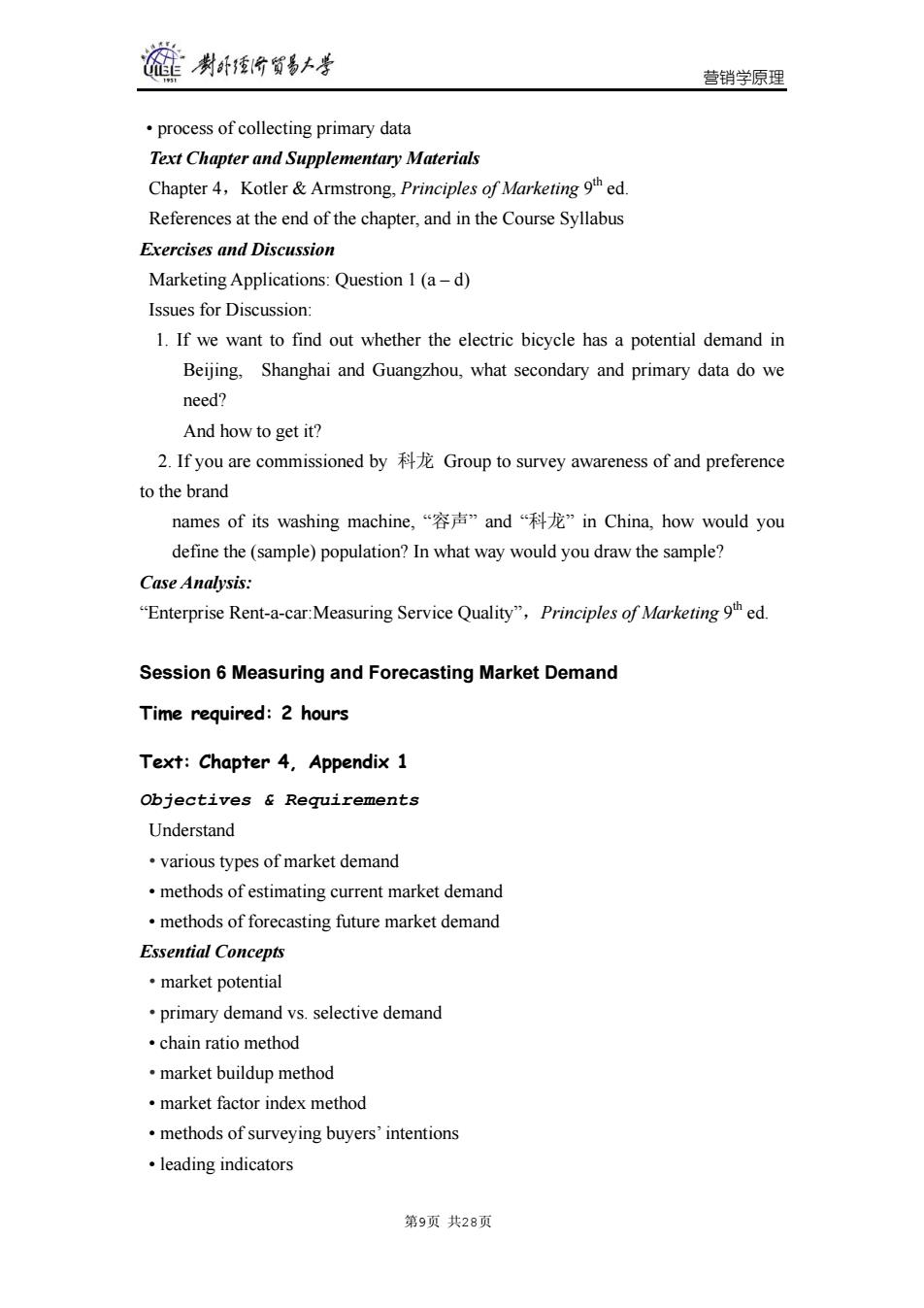
莲 制卧价贸易+学 营销学原理 process of collecting primary data Text Chapter and Supplementary Materials Chapter 4,Kotler&Armstrong,Principles of Marketing ed. References at the end of the chapter,and in the Course Syllabus Exercises and Discussion Marketing Applications:Question 1 (a-d) Issues for Discussion: 1.If we want to find out whether the electric bicycle has a potential demand in Beijing,Shanghai and Guangzhou,what secondary and primary data do we need? And how to get it? 2.If you are commissioned by Group to survey awareness of and preference to the brand names of its washing machine,“容声”and“科龙”in China,how would you define the (sample)population?In what way would you draw the sample? Case Analysis: "Enterprise Rent-a-car:Measuring Service Quality",Principles of Marketing 9th ed. Session 6 Measuring and Forecasting Market Demand Time required:2 hours Text:Chapter 4,Appendix 1 Objectives Requirements Understand various types of market demand methods of estimating current market demand methods of forecasting future market demand Essential Concepts ·market potential primary demand vs.selective demand ·chain ratio method market buildup method market factor index method methods of surveying buyers'intentions ·leading indicators 第9页共28页
营销学原理 • process of collecting primary data Text Chapter and Supplementary Materials Chapter 4,Kotler & Armstrong, Principles of Marketing 9th ed. References at the end of the chapter, and in the Course Syllabus Exercises and Discussion Marketing Applications: Question 1 (a – d) Issues for Discussion: 1. If we want to find out whether the electric bicycle has a potential demand in Beijing, Shanghai and Guangzhou, what secondary and primary data do we need? And how to get it? 2. If you are commissioned by 科龙 Group to survey awareness of and preference to the brand names of its washing machine, “容声” and “科龙” in China, how would you define the (sample) population? In what way would you draw the sample? Case Analysis: “Enterprise Rent-a-car:Measuring Service Quality”,Principles of Marketing 9th ed. Session 6 Measuring and Forecasting Market Demand Time required: 2 hours Text: Chapter 4, Appendix 1 Objectives & Requirements Understand • various types of market demand • methods of estimating current market demand • methods of forecasting future market demand Essential Concepts • market potential • primary demand vs. selective demand • chain ratio method • market buildup method • market factor index method • methods of surveying buyers’ intentions • leading indicators 第9页 共28页
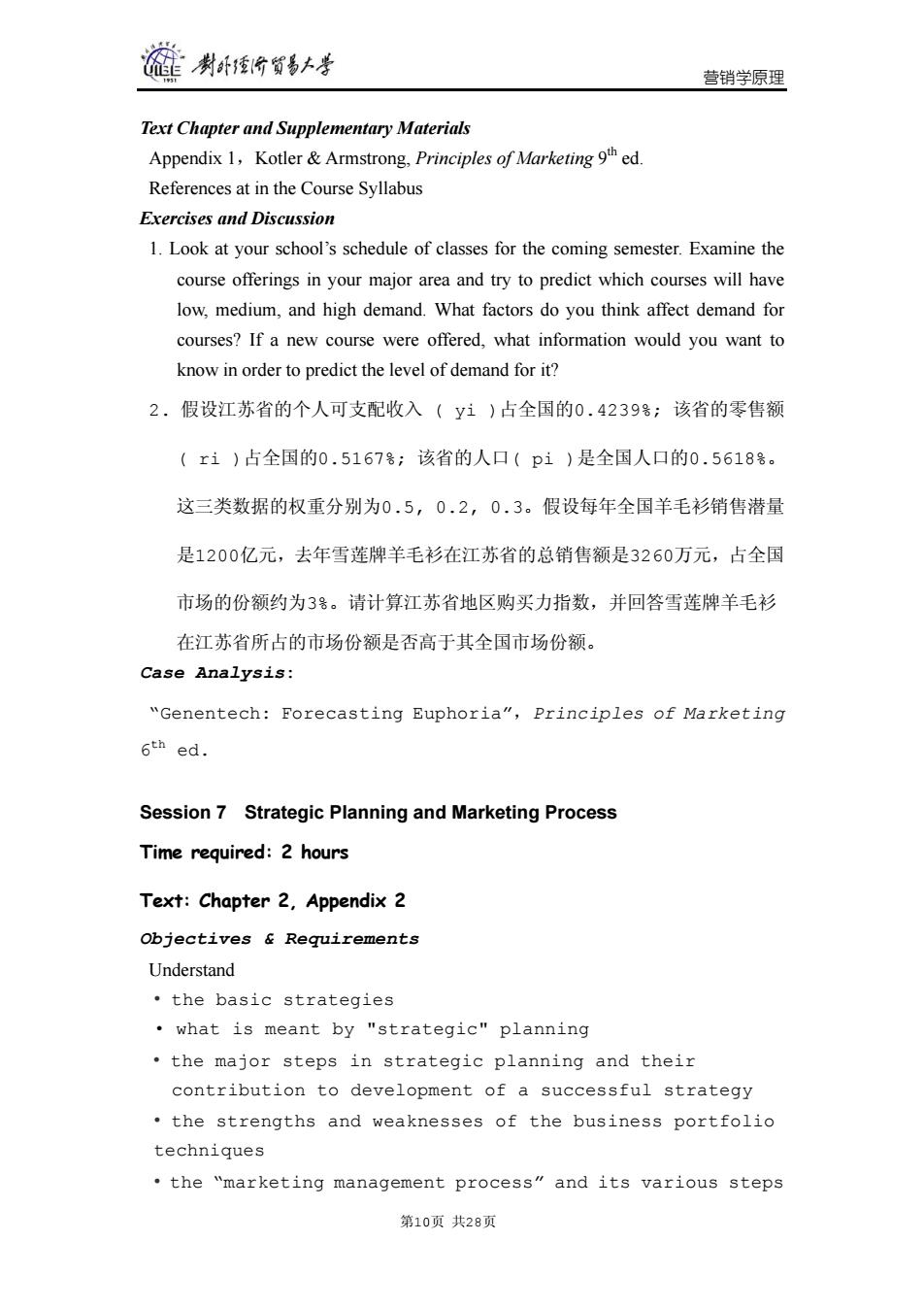
溢 制卧台贸易上考 营销学原理 Text Chapter and Supplementary Materials Appendix 1,Kotler Armstrong,Principles of Marketing 9th ed. References at in the Course Syllabus Exercises and Discussion 1.Look at your school's schedule of classes for the coming semester.Examine the course offerings in your major area and try to predict which courses will have low,medium,and high demand.What factors do you think affect demand for courses?If a new course were offered,what information would you want to know in order to predict the level of demand for it? 2.假设江苏省的个人可支配收入(yi)占全国的0.4239号;该省的零售额 (ri)占全国的0.5167号;该省的人口(pi)是全国人口的0.5618号。 这三类数据的权重分别为0.5,0.2,0.3。假设每年全国羊毛衫销售潜量 是1200亿元,去年雪莲牌羊毛衫在江苏省的总销售额是3260万元,占全国 市场的份额约为3号。请计算江苏省地区购买力指数,并回答雪莲牌羊毛衫 在江苏省所占的市场份额是否高于其全国市场份额。 Case Analysis: "Genentech:Forecasting Euphoria",Principles of Marketing 6th ed. Session 7 Strategic Planning and Marketing Process Time required:2 hours Text:Chapter 2,Appendix 2 Objectives Requirements Understand ·the basic strategies what is meant by "strategic"planning the major steps in strategic planning and their contribution to development of a successful strategy the strengths and weaknesses of the business portfolio techniques the "marketing management process"and its various steps 第10页共28页
营销学原理 Text Chapter and Supplementary Materials Appendix 1,Kotler & Armstrong, Principles of Marketing 9th ed. References at in the Course Syllabus Exercises and Discussion 1. Look at your school’s schedule of classes for the coming semester. Examine the course offerings in your major area and try to predict which courses will have low, medium, and high demand. What factors do you think affect demand for courses? If a new course were offered, what information would you want to know in order to predict the level of demand for it? 2. 假设江苏省的个人可支配收入 ( yi )占全国的0.4239%; 该省的零售额 ( ri )占全国的0.5167%; 该省的人口( pi )是全国人口的0.5618%。 这三类数据的权重分别为0.5, 0.2, 0.3。假设每年全国羊毛衫销售潜量 是1200亿元,去年雪莲牌羊毛衫在江苏省的总销售额是3260万元,占全国 市场的份额约为3%。请计算江苏省地区购买力指数,并回答雪莲牌羊毛衫 在江苏省所占的市场份额是否高于其全国市场份额。 Case Analysis: “Genentech: Forecasting Euphoria”,Principles of Marketing 6th ed. Session 7 Strategic Planning and Marketing Process Time required: 2 hours Text: Chapter 2, Appendix 2 Objectives & Requirements Understand • the basic strategies • what is meant by "strategic" planning • the major steps in strategic planning and their contribution to development of a successful strategy • the strengths and weaknesses of the business portfolio techniques • the “marketing management process” and its various steps 第10页 共28页